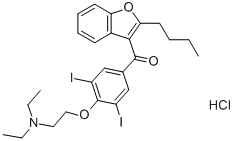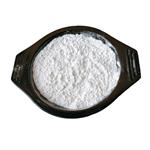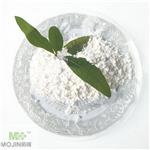Amiodarone HCl (19774-82-4) is a nonselective ion channel blocker. Class III antiarrhythmic.1 Induces cytochrome c release and induces apoptosis.2 An alkalizing agent which stimulates progranulin (GRN) production and prevents GRN-dependent neurodegeneration.3 Induces autophagy and suppresses hepatocellular carcinoma tumorigenesis via autophagy-mediated MIR224 degradation in vitro and in vivo.4
Cordarone,Labaz,France,1971
Amiodarone induces an immediate influx of Ca2+ in Saccharomyces cerevisiae, followed by mitochondrial fragmentation and cell death.
Antiarrhythmic;Na+ channel blocker
A non-selective ion channel blocker. Antiarrhythmic (class III)
Amiodarone hydrochloride is a non-selective ion channel blocker with broad fungicidal activity. Amiodarone induces an immediate influx of Ca2+ in Saccharomyces cerevisiae, followed by mitochondrial fragmentation and cell death. Amiodarone hydrochloride has also been used in a study to determine concentrations of thyroid disrupting substances in effluents from wastewater treatment plants.
ChEBI: Amiodarone hydrochloride is an aromatic ketone.
135 grams of 2-n-butyl-3-(3,5-diiodo-4-hydroxybenzoyl)benzofuran dissolved
in 600 cc of ethyl carbonate were treated with 5.7 grams of sodium in the
form of sodium methoxide in methanol. Then, β-diethylaminoethyl chloride
which had been obtained from 51.6 grams of the hydrochloride in ethyl carbonate was introduced into a suspension of the sodium salt. The mixture
was heated to a temperature of approximately 90°C which was maintained for
approximately 2 hours. The mixture was cooled and allowed to stand
overnight during which time the sodium chloride settled down.
The toluene solution containing diethylaminoethyl ether was extracted with
increasingly diluted aqueous hydrochloric acid solutions while stirring.
Extraction was continued until the alkalized solution produced no further
precipitate. The combined aqueous solutions were washed with ether and then
made strongly alkaline with aqueous sodium hydroxide. Extraction with ether
was carried out three times. The organic layers were washed with water and
then dried over anhydrous potassium carbonate. In order to produce the
hydrochloride, the carbonate was filtered off and then the hydrochloride was
precipitated from the ether solution with an ethereal hydrochloric acid
solution. After the solution had been allowed to stand for a few hours,
decantation was carried out and the syrupy hydrochloride residue was taken
up in 500 cc of boiling acetone. The salt crystallized out by cooling. The
substance was allowed to stand overnight at 0°C, and centrifuged, washed
with ethyl acetate and then with ether and dried. 130 grams of 2-n-butyl-3-
(3,5-diiodo-4-β-N-diethylaminoethoxybenzoyl)benzofuran hydrochloride in the
form of a crystalline powder which melts at 156°C were obtained.
Amiodarone, marketed as Pacerone?, Cordarone?, Aratac, and Atlansil, is an antiarrhythmic agent monitored by clinical labs using HPLC or LCMS to ensure patients remain within the drugs therapeutic range.
Non-selective ion channel blocker with broad fungicidal activity. Amiodarone induces an immediate influx of Ca2+ in Saccharomyces cerevisiae, followed by mitochondrial fragmentation and cell death.
Veterinary Drugs and Treatments
Because of its potential toxicity and lack of experience with use in
canine and equine patients, amiodarone is usually used when other
less toxic or commonly used drugs are ineffective. It may be useful
in dogs and horses to convert atrial fib into sinus rhythm and in
dogs for arrhythmias associated with left ventricular dysfunction. In
horses, one horse with Ventricular tachycardia was converted into
sinus rhythm using amiodarone.
As the risk of sudden death is high in Doberman pinschers exhibiting
rapid, wide-complex ventricular tachycardia or syncope with
recurrent VPC’s, amiodarone may be useful when other drug therapies
are ineffective.
Potentially hazardous interactions with other drugs
Anti-arrhythmics: additive effect and increased
risk of myocardial depression; increased risk
of ventricular arrhythmias with disopyramide
or dronedarone - avoid; increased flecainide
concentration - halve flecainide dose; increased
procainamide concentration - avoid.
Antibacterials: increased risk of ventricular
arrhythmias with parenteral erythromycin, co�trimoxazole levofloxacin and moxifloxacin - avoid;
increased risk of ventricular arrhythmias with
delamanid; avoid with fidaxomicin; possibly
increased risk of ventricular arrhythmias with
telithromycin.
Anticoagulants: metabolism inhibited (increased
anti-coagulant effect); increased dabigatran
concentration (reduce dabigatran dose).
Antidepressants: increased risk of ventricular
arrhythmias with citalopram and escitalopram,
tricyclic antidepressants and venlafaxine - avoid.
Antiepileptics: phenytoin and fosphenytoin
metabolism inhibited (increased concentration).
Antifungals: avoid with fluconazole due to risk of
QT prolongation.
Antihistamines: increased risk of ventricular
arrhythmias with mizolastine - avoid.
Antimalarials: increased risk of ventricular
arrhythmias with chloroquine, hydroxychloroquine,
mefloquine and quinine and possibly with
piperaquine with artenimol and artemether/
lumefantrine - avoid.
Antimuscarinics: increased risk of ventricular
arrhythmias with tolterodine.
Antipsychotics: increased risk of ventricular
arrhythmias with antipsychotics that prolong
the QT interval; increased risk of ventricular
arrhythmias with amisulpride, benperidol,
droperidol, haloperidol, phenothiazines, pimozide or
zuclopenthixol - avoid; increased risk of ventricular
arrhythmias with sulpiride.
Antivirals: increased risk of ventricular arrhythmias
with fosamprenavir ritonavir, saquinavir and
telaprevir - avoid; concentration possibly increased
by atazanavir; possible increased risk of bradycardia
with daclatasvir, ledipasvir, sofosbuvir and
simeprevir; avoid with indinavir, reduce the dose of
the others.
Atomoxetine: increased risk of ventricular
arrhythmias.
Beta-blockers, diltiazem, and verapamil: increased
risk of bradycardia, AV block and myocardial
depression; increased risk of ventricular arrhythmias
with sotalol - avoid.
Ciclosporin: increased levels of ciclosporin possible.
Cobicistat: concentration possibly increased by
cobicistat - avoid.
Colchicine: possibly increased colchicine toxicity.
Cytotoxics: possibly increased afatinib concentration
(separate administration by 6-12 hours); possibly
increased risk of ventricular arrhythmias with
panobinostat and vandetanib - avoid; concentration
of ibrutinib possibly increased - reduce dose of
ibrutinib; avoid with idelalisib; increased risk of
ventricular arrhythmias with arsenic trioxide,
bosutinib and ceritinib.
Digoxin: increased concentration (halve digoxin
maintenance dose).
Fingolimod: possible increased risk of bradycardia.
Grapefruit juice: may increase concentration of
amiodarone - avoid.
Ivabradine: increased risk of ventricular arrhythmias
- avoid.
Lipid-lowering drugs: give lomitapide 12 hours
after amiodarone; increased risk of myopathy with
simvastatin - do not exceed 20 mg of simvastatin.1 Lithium: increased risk of ventricular arrhythmias -
avoid.
Pentamidine: increased risk of ventricular
arrhythmias - avoid.
Amiodarone is metabolised in the liver; the major
metabolite, desethylamiodarone, also has antiarrhythmic
properties. There is very little urinary excretion of
amiodarone or its metabolites, the major route of
excretion being in faeces via the bile; some enterohepatic
recycling may occur.
1) Yamase et al. (2012), Effectiveness of amiodarone versus bepridil in achieving conversion to sinus rhythm in patients with persistent atrial fibrillation: a randomized trial; Heart, 98 1067
2) Di Matola et al. (2000), Amiodarone induces cytochrome c release and apoptosis through an iodine-independent mechanism; J. Clin. Endocrinol. Metab., 85 4323
3) Capell et al. (2011), Rescue of progranulin deficiency associated with frontotemporal lobar degeneration by alkalizing reagents and inhibition of vacuolar ATPase; J. Neurosci., 31 1885
4) Lan et al. (2014), Autophagy-preferential degradation of MIR224 participates in hepatocellular carcinoma tumorigenesis; Autophagy, 10 1687



